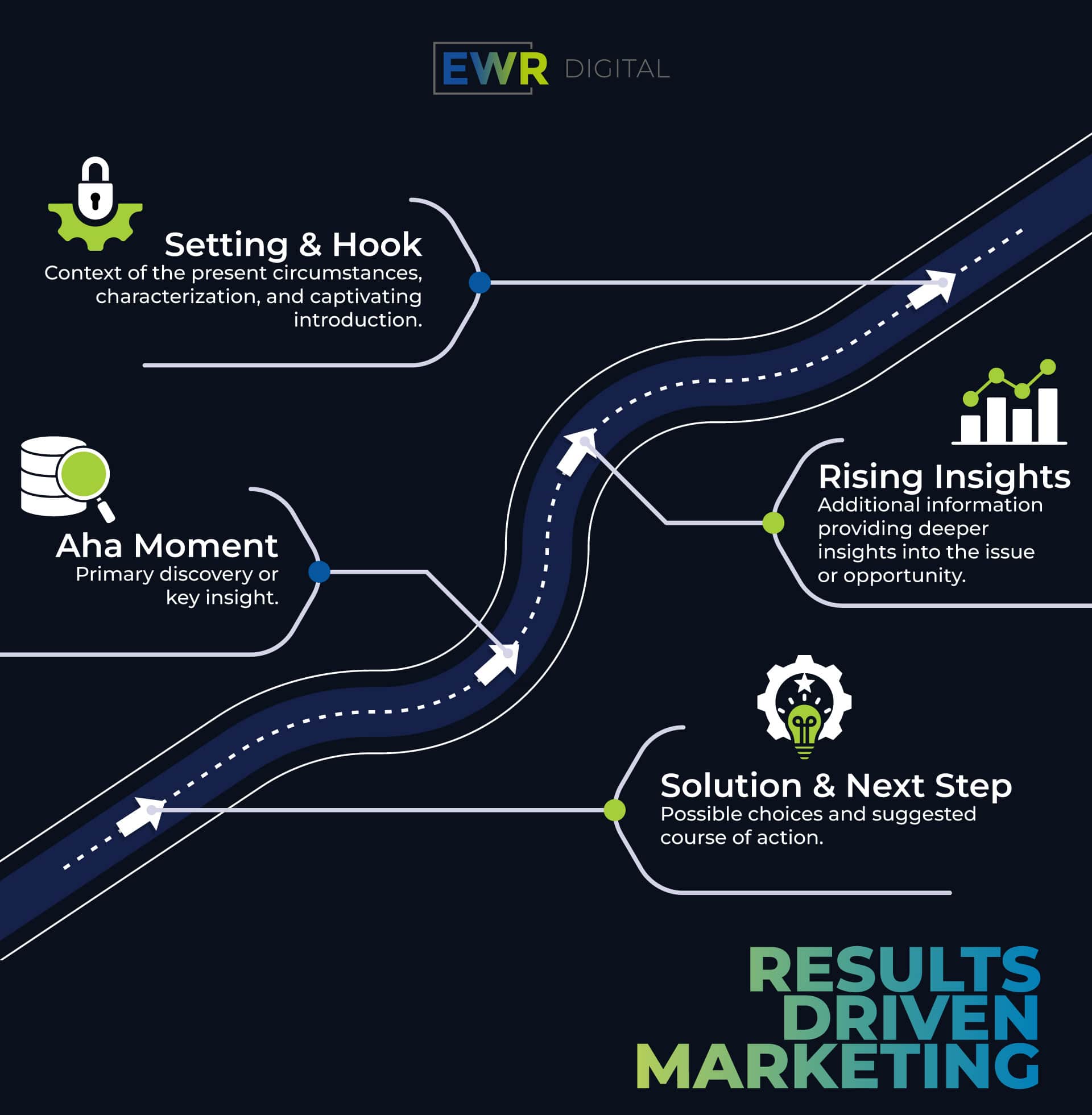
Adding storytelling to your digital marketing will help showcase your brand’s personality so customers can easily understand what your brand is about. It goes beyond the typical aggressive marketing approaches to help you establish a human connection with your target audience in a way that leaves a lasting impression.
How to Master the Art of Storytelling for Your Company
Storytelling isn’t rocket science, and you don’t have to be an English professor to tell a good story. With these steps, you can master the art of storytelling and produce engaging content every time.
Know Your Brand
You need to have a clear understanding of your brand before telling a good brand story. Knowing your brand doesn’t just mean being familiar with your brand name, logo, and color. You need to understand what your brand stands for, why your customers need you, and the kind of message you want to communicate to your target audience.
You should also have a clear stand on your business’s problem and your positioning in the market relative to your competition. You need to analyze your brand yourself and listen to prospects, customers, and employees about what motivates their decisions about your brand.
Clearly Define Your Vision
After you’ve figured out your brand’s identity, you should state your vision and clearly outline it for easy remembrance. Even if you already have a beautifully crafted vision statement, you might need to revisit it and make changes to reflect your brand’s identity. You can easily build your storytelling around it and use it as a reference tool for your other digital marketing campaigns when you have a clear vision.
Know Your Audience
The next step after discovering your brand is to understand your target market from a genuine perspective. You can’t tell an engaging brand story if you don’t know who you’re narrating it to. Find out about your audience’s age, interests, educational, and cultural backgrounds.
Audience information will help you select the right language to use in your story and know how long your story should be. For instance, you’d know if a playful or a professional tone would be more appropriate. You can also figure out the best platform for publishing your story to reach the right audience.
Think About Experiences You Can Turn into a Story
Getting ideas for a brand story requires some introspection. Think about your brand’s journey and your customers’ experiences to create a beautiful narrative. You can start by looking at specific challenges your customers face and ask yourself if it would make a great story.
To do this, you might need to gather insights from your customers through surveys or what you hear from customer service feedback. Alternatively, you can write case studies about some of your regular customers. You can make them the characters in your brand story by featuring them. If you’re choosing this method, try to add more personality or story elements to your piece.
Maintain A Flow
Much like other types of writing, brand storytelling should have a flowing narrative. Include the major storytelling elements in your piece: a character, setting, conflict, story plot, and theme. The character of your brand story is the person or people taking part in the action. The setting is the time and place where the action took place, while the plot is the series of events surrounding the story you’re telling. The conflict is the struggle before making a decision, and the theme is the central idea of the story you’re telling. With a definite flow, you’re more likely to keep your audience engrossed in your story.
Start With Your Audience, Not Yourself
To succeed as a brand storyteller, start your story by talking about your audience, not yourself or your brand. Not talking about yourself might come as a surprise to many, but people generally appreciate it when a conversation is relevant to them. Start from your customer’s needs, interests, and ambitions. Leave those punchlines about your brand’s unique selling points for another marketing strategy.
Make Your Audience the Star of the Story
Although you’re narrating your brand’s story, you shouldn’t put yourself in the center of the story. Eliminate the boundary between your story and your audience by making them the hero of your narrative. You can do this by engaging them with a question or two that puts them at the center of the story. That way, your audience will have a first-hand experience of your narrative, and they’ll be interested in experiencing it in real life.
Capture The Audience’s Interest
Ensure you capture your audience’s interest and give them a reason to pay attention to your brand story and not just skim through. To do this, ensure that your story is relevant to your target audience. Apart from serving as a marketing tool for your brand, your story should have a message or lesson embedded in it and engage your audience intellectually or emotionally.
For example, you can use your narrative to pass a message about climate change, free speech, conquering fear, or taking bold steps in life. Whatever your message, make it known to your audience from the word ”go.”
Be Authentic
Authenticity is the key to gaining your audience’s trust through storytelling. Avoid pitching an over-the-top tale to impress your readers. People can tell when you’re trying to pull a fast one on them; you’ll lose their attention if you do. If your brand story doesn’t have a mind-blowing tale, don’t try to fabricate one. You’re more likely to connect with your audience through a genuine narrative.
Acknowledge the human aspect of your brand through transparency. Being transparent will help create an emotional connection with your audience and reveal laudable characteristics like resilience and innovation.
Engage Your Reader’s Senses
People experience the world through their senses, so if you want to captivate your audience, engage their senses. To do this, recreate the scene of your story and give your audience the context. When describing where your story took place, go a step further by telling your audience what the air smelled like and how it felt to be there. By engaging their senses, you immerse them into your experience.
Describe the Emotions
Humans are naturally emotional, and even if we easily forget the details about an adventure, the memory of how it made us feel will last longer, maybe forever. Emotions pull an audience faster into a story than just words. It makes them understand your perspective and engage with your message.
So, in your storytelling, please don’t stop at saying what happened; describe how it made you feel. Think of emotions as an arm that reaches out to your audience and draws them to your story.
Remember Why You’re Telling the Story
Don’t lose sight of the big picture. Always remember why you’re telling the story. You’re likely doing it to sell your brand eventually, but it shouldn’t feel that way to your audience.
So, while walking your reader through your experience, creatively insert relevant details about your brand. If you include statistics, wrap a story around it. Your story can be emotional, funny, or something different, but always keep your vision in sight when narrating.
Spark The Consumer’s Curiosity
Make your narrative intense, so your audience is completely engrossed until they get to the end. You can arouse curiosity and suspense by catapulting your audience straight into the mindset of all the action or giving them a glimpse of the end at the beginning.
Your audience will likely be interested in reading your entire piece to solve the missing pieces of the puzzle but avoid going overboard with the suspense by making it complicated.
Go Beyond Words
You can use pictures and videos to support your written stories. Pictures can help make your story more memorable and convey your message quickly. They also entertain your audience and give them a feel of the action or experience you described with words.
You can also use pictures to build your brand by adding clever words and phrases to them. You can even take it a step further by creating unique hashtags for them and using the hashtags on your social media channels.
Bring Your Story to a Grand Close
After you reach the peak of your story by building up the suspense, bring it to a gradual close. Finish the plot of your story and leave no questions unanswered unless you intend to continue the story in subsequent narratives.
Don’t make your story end boring; give it a grand close by leaving your audience amazed, similar to how you feel after seeing a mind-blowing film at the cinema. One way to do this is by leaving your audience with an intriguing question about humanity.
Spur Your Audience to Act Without Being Aggressive
Your brand story should have a clear outcome. Leave your audience with an actionable point that will compel them to connect with your brand. You could use a real-life experience to convey a message about your brand. The message should give them an idea of who you are and spark confidence in your offerings and values.
Try not to come out as being aggressive with your call to action. People tend to lose interest and even resist aggressive approaches like that. You don’t want to pass the wrong message about your brand and ruin a great story.
Insert a Talk Trigger
Your story shouldn’t stop at being memorable; it should get people talking. You can do this by inserting a talk trigger in your narrative. A talk trigger is an aspect of your story that puts your brand on the lips of your audience. When you strategically create a talk trigger in your story, your customers start spreading word of mouth about your business. That’s cost-effective marketing for you.
To design a talk trigger, identify or create something unusual about your brand and chip it into your story. For example, you could be a shoe brand but have an extensive gym wear collection.
Read It Aloud
People are usually quiet when writing and type out the words they think will sound good. If you want to improve your storytelling skills, you should read aloud what you’ve written. Reading what you’ve written aloud will help you pay closer attention to your words and hear how they sound to your audience.
You will easily catch mistakes and unnecessary or awkward phrases in your writing and cut out the fluff. Also, reading aloud helps you find your writing rhythm to create a story with a memorable melody. It can also help you find your writing voice since you’ll hear what your words sound like and identify how much you’re improving.
Publish Your Story and Pay Attention to the Buzz
After you’ve created your brand story, spread the word by publishing your piece and sharing it on as many channels as possible. You didn’t go through all that trouble crafting a masterpiece only to have it sit on your website with few views. Repost it on your company’s social channels and make it easily visible on your website.
Once you’ve gotten the word out, please pay attention to how your audience reacts to it. Take note of the areas your readers are most interested in and build upon it when telling your next brand story. That way, you’ll hone your storytelling skills and become a pro at it. Don’t forget to respond to comments and questions on your website and social media pages because it’s crucial in digital marketing.
Be Consistent on All Channels
The narrative you’re creating isn’t just about a specific experience but about your entire brand. So, avoid leaving customers confused with a story that doesn’t reflect the other aspects of your brand. When telling your story, ensure you’re consistent across all your other channels.
Where possible, repeat verbiage associated with your brand and use the same logo and color when publishing your story. Repeating your brand’s verbiage will help create brand awareness and reinforce your brand’s identity in the eyes of people who have encountered it in the past.
Storytelling, Something Everyone can Relate To
At EWR Digital, we don’t believe in a one-size-fits-all solution. Your needs aren’t the same as everyone else’s. If you need help with digital storytelling, EWR Digital is the one to call. We want to know exactly what your goals are before we collaborate with you to create an SEO strategy that helps your company grow and thrive. Contact us today to get your digital strategy started!


